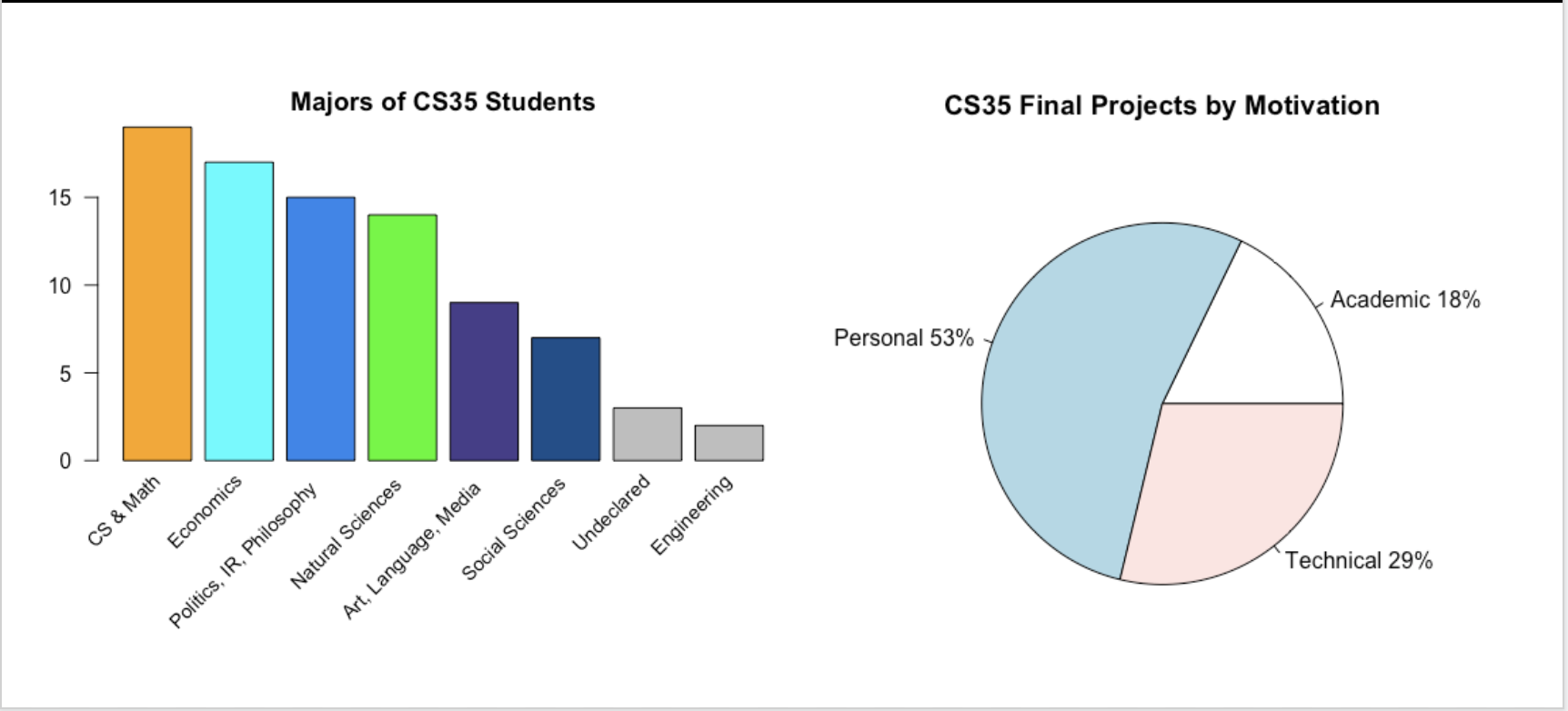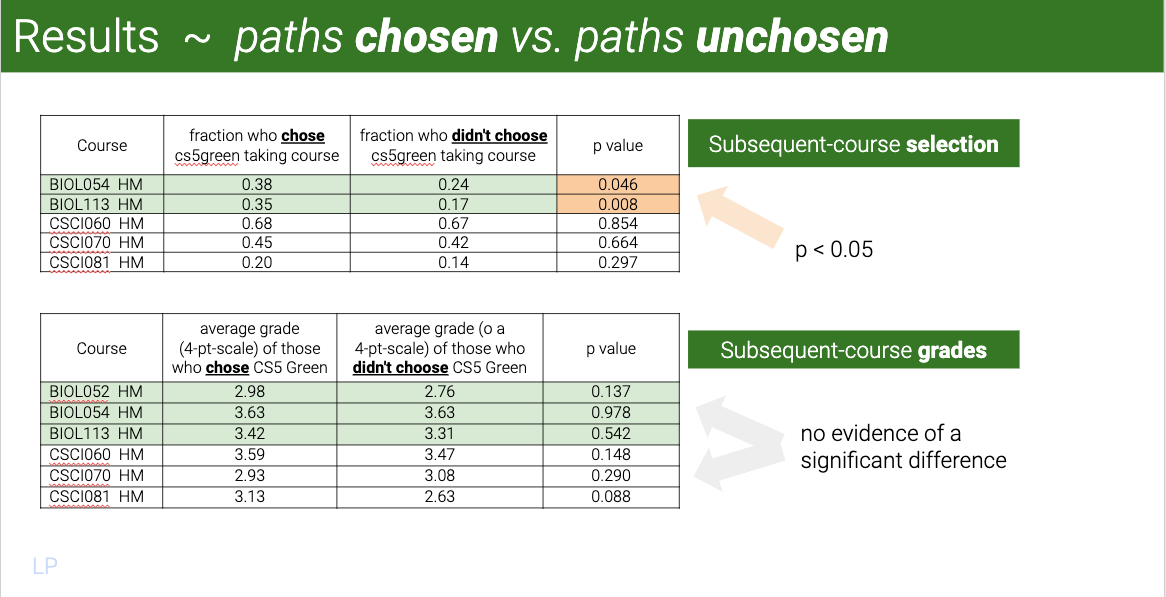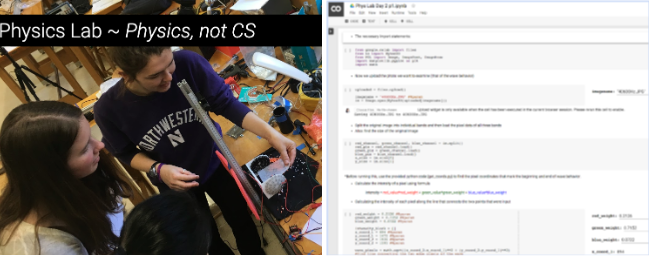CS35 also CS181y
CS for Inquiry
and CS for Insight
aka Connective Computing and
Scripting for All
An Opportunity and Challenge
Computing has long been a valuable specialty. Increasingly, computational skillsets, toolsets, and mindsets are being considered a cornerstone of professional literacy, akin to cogent writing, critical reading, and compelling presentation. (Even if not quite as universal!)
CS departments evolved to convey the valuable specialty of CS. Institutional structures for developing the professional literacy of computing, however, are far less mature. This NSF project, Computing for Insight or CFI (also nicknamed "Scripting for All") explores how post-secondary paths can most effectively help all students -- especially non-CS majors -- gain confidence and comfort with the literacy of computing.
Thus far, the most important insights gained have been
- In no way do Literature departments own writing. By the same token, in no way do CS departments own computing. This latter truth is less widely acknowledged. Embracing it, it becomes clear that computing does not, per se, threaten any academic identity -- at least no more than writing (or reading or presentation) does.
- Literacies are most effectively developed within another academic identity. To that end, CFI has sought to create curricula outside of CS in which to develop computing skills. The sciences have been the natural - and successful start. In summer 2019 we are creating material that seeks to reach beyond the natural and physical sciences -- without neglecting those close allies!
- Although CS does not own computing, and computing (while useful) isn't central in non-CS disciplines, it is also the case that CS departments have the chance to team up with their academic siblings in order to serve students -- of all interests and identities -- who would like to embrace or experiment with computing skills. CFI sees such efforts as "bridge building" from and to CS and other disciplines, such that students have a variety of paths for developing computing confidence that will serve them in the academic identities they have chosen.
- We believe that an important part of this bridge-building is expanding the set of computing courses designed for non-CS majors. HMC's CS35, CS for Insight, is an example of such a course. Similarly, CS5, especially its Green section (using only biological contexts to convey computing ideas) fits this description. CFI experiments with and examines the results of these efforts.
The Goal
CFI developes and strengthens bridges between computing and other traditional disciplines, specifically in service to non-CS academic identities. There are many fields in which computation can provide value (not all), without an identity-based focus on computation per se. Because computing is younger than reading, writing, and presentation, there are fewer opportunities for pre-college students to develop those skills.
 |
The vast majority of students who have taken the four offerings of CS35 pursue majors in fields outside of CS. Economics, for example, embraces computation as a means to express and evaluate its models and insights. Even in fields where computing does not obviously contribute, many students seek a foundation from which they then decide where computing can effectively amplify their efforts.
Since 2009, HMC has offered an introduction-to-computing pathway that uses biology as the context and motivation for the concepts practced. This course, CS5 Green, provides students with the tools necessary to take a computation problem in biology and go through the entire process of designing, implementing, documenting, and testing a solution. The addition of computation gives students a new window to solve new problems found in the biological sciences, while understanding how the computation is being performed.
 |
As part of CFI's research, we have examined the course-choices of students whose introductory computing experience was CS5 green, comparing them with those of students who began in a more generic introductory course (CS5 gold). The former cohorts chose to take an equal number of subsequent computing courses and performed equally well in them. That is, student pathways are not compromised by contextualized introductions to computing.
In addition, we compared the outcomes for students who chose cs5 green with those who were simply placed there for other reasons, e.g., scheduling constraints or class-size balance. We were both surprised and heartened that there were no differences in subsequent interest in computing. (We were not surprised that there were differences in subsequent interest in biology.) Results such as these strongly suggest computing's role as a professional literacy, beyond its sibling status as a liberal art and engineering pursuit.
A more recent expansion of compositional computing has been developed through this project and deployed in HMC's Physics 50. This is another non-CS-major course that has embraced a subsidiary role for script-use and script-building in support of the physical insights that are the course's goals.
 |
Here, the interfaces used are Google sheets and Google Colab: far better suited to support the lab work at the heart of the course. We believe other courses will benefit from emerging interfaces that let computing contribute to other efforts -- without taking any more energy or attention than necessary.
- IT University Copenhagen: Invited talk on Gender and Diversity in IT
- Interdisciplinary Computing Summer Institute presentation: Summer 2018, San Jose State
- Consortium for Computing Sciences in Colleges - Southwest 2018 Presentation
- Computing for All Academic Identities Consortium for Computing Sciences in Colleges - Southwest 2018 Paper
- UC Riverside Fall 2018
- CS for All Academic Identities SIGCSE 2018 Poster presentation
- CS for Insight: Scripting for All (Disciplines) SIGCSE 2018 Poster presentation
- SIGCSE 2019 Workshop: Embracing our Future: CS Courses and Curriculum for Non-CS-majors
- Beaver Works Summer Institute 2018 - MIT
- CS5 Green
- Physics 50
- CS121 Software Engineering
- CS35: CS for Insight
grading guidelines for cs35